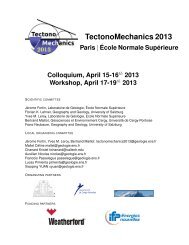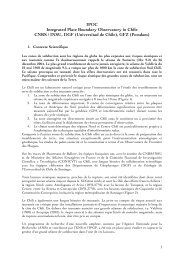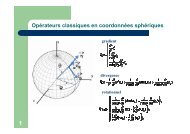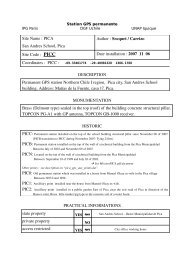PDF file - Laboratoire de Géologie de l'Ecole normale supérieure - Ens
PDF file - Laboratoire de Géologie de l'Ecole normale supérieure - Ens
PDF file - Laboratoire de Géologie de l'Ecole normale supérieure - Ens
You also want an ePaper? Increase the reach of your titles
YUMPU automatically turns print PDFs into web optimized ePapers that Google loves.
VIGNY ET AL.: GEODETIC MEASUREMENTS MONITOR ASAL RIFT DEFORMATION<br />
smaller than estimated for the 1974 Krafla crisis in<br />
Iceland [Foulger et al.,1992]. The diffusivity measures<br />
the ratio of the length scale to the square root of the<br />
time scale. The time scale is the time between the<br />
rifting episo<strong>de</strong> and the second geo<strong>de</strong>tic survey, i.e. 19<br />
years at Asal and 11 years at Krafla. The length scale<br />
is the distance from the rift axis to the fastest-moving<br />
point, 3 km at Asal, consi<strong>de</strong>rably shorter than the 25<br />
km at Krafla. The diffusivity ratio for Asal with<br />
respect to Krafla is ~1/70, implying that the top elastic<br />
layer (crust ?) is at least an or<strong>de</strong>r of magnitu<strong>de</strong> thinner<br />
beneath Asal and/or that the viscosity of the<br />
un<strong>de</strong>rlying half-space (mantle ?) is at least an or<strong>de</strong>r of<br />
magnitu<strong>de</strong> higher at Asal than at Krafla. Although<br />
these differences are qualitatively consistent with the<br />
tectonic settings of Djibouti and Iceland, their stark<br />
quantitative contrast suggests that the 1-dimensional<br />
analysis oversimplifies the problem somewhat.<br />
In a subsequent paper [Cattin et al., 2005], we<br />
argue that the geometric consi<strong>de</strong>rations (multiple<br />
dipping, non-planar faults) and thermal effects (postrifting<br />
cooling increases viscosity) require a complete<br />
3-dimensional approach, using numerical mo<strong>de</strong>ling.<br />
Such a mo<strong>de</strong>l is required to explain the <strong>de</strong>tails of the<br />
inner rift <strong>de</strong>formation. For example, the geo<strong>de</strong>tic data<br />
suggest that the northern part of the rift zone<br />
accommodates more (some 70%) of the extension than<br />
the southern part.<br />
Consi<strong>de</strong>ring the amount of extension absorbed in<br />
the Asal rift during the 1978 sequence, the high postseismic<br />
velocity, and the present-day velocity, we<br />
infer that the opening rate across the Asal rift will<br />
have to <strong>de</strong>crease significantly before the next such<br />
seismo-volcanic crisis can occur. The <strong>de</strong>formation<br />
recor<strong>de</strong>d by the topography as well as the <strong>de</strong>formation<br />
recor<strong>de</strong>d by the lake Asal Holocene markers, suggest<br />
that the recurrence time of such a crisis is about 120 to<br />
300 yr [Ruegg et al., 1990; Stein et al., 1991;<br />
Manighetti et al., 1998]. However, the ongoing high<br />
rate and the fact that the whole system is being<br />
uplifted is an indication that magma injection still<br />
prevails over extension as the active process driving<br />
the rifting today.<br />
Acknowledgments<br />
We are grateful to many people who occasionally<br />
participated in measurement campaigns: in particular<br />
people from the “Observatoire d’Arta”, and especially<br />
to J.-C. Delmont who was director during the 1991<br />
campaign and participated in 1995 and 1999. The<br />
leveling line was surveyed by A. Coulomb from IGN.<br />
Very special thanks to Moumin in Djibouti. The Afar<br />
geo<strong>de</strong>tic program was sponsored by CNRS/INSU<br />
programs (Tectoscope-Positionnement, IDHYL, IT).<br />
We also appreciate the guidance of Peter Molnar,<br />
whose NSF grant (OCE8916680) boosted the 1991<br />
campaign.<br />
10<br />
References<br />
Abdallah, A. V. Courtillot, M. Kasser, A.Y. Le Dain,<br />
J.C. Lepine, B. Robineau, J.C. Ruegg, P. Tapponnier<br />
and A. Tarantola, Relevance of Afar seismicity and<br />
volcanism to the mechanics of accreting plate<br />
boundaries, Nature, 282, 17-23, 1979.<br />
Acton, G.D., and Stein S., Block rotation and<br />
continental extension in Afar: a comparison to<br />
oceanic microplate systems. Tectonics, 10, 501-526,<br />
1991.<br />
Altamimi, Z., P. Sillardand C. Boucher, ITRF2000: A<br />
new release of the International Terrestrial<br />
Reference frame for earth science applications, J.<br />
Geophys. Res.-SA 107 (B10): art. no. 2214, 2002.<br />
Asfaw, L. R., R. Bilham, M. Jackson and P. Mohr,<br />
Recent inactivity in African rift, Nature, 357, 447,<br />
1992.Ballu, V., M. Diament, P. Briole and J.C.<br />
Ruegg, 1985-1999 gravity field variations across the<br />
Asal rift: insights on vertical movments and mass<br />
transfer, Earth Planet. Sci. Lett., 208, 41-49, 2003.<br />
Besse, J., and V. Courtillot, Revised and synthetic<br />
apparent polar wan<strong>de</strong>r paths of the African,<br />
Eurasian, North American and Indian plates, and<br />
true polar wan<strong>de</strong>r since 200 Ma, J. Geophys. Res.,<br />
96, 4029-4050, 1991.<br />
Beutler, G., J. Kouba, and T. Springer, Combining the<br />
orbits of the IGS processing centers, in proceedings<br />
of IGS annalysis center workshop, edited by J.<br />
Kuba, 20-56, 1993.<br />
Cattin, R., C. Doubre, J.B. <strong>de</strong> Chabalier, G. King, C.<br />
Vigny, J.P. Avouac and J.C. Ruegg, Numerical<br />
mo<strong>de</strong>lling of quaternary <strong>de</strong>formation and post-rifting<br />
displacement in the Asal-Ghoubbet rift (Djibouti,<br />
Africa), Earth Planet. Sc. Lett., 239, 352-367, 2005.<br />
Courtillot, V., A. Gal<strong>de</strong>ano and J.L. LeMouel,<br />
Propagation of an accreting plate boundary: a<br />
discussion of new aeromagnetic data in the gulf of<br />
Tadjourah and southern Afar. Earth Planet. Sci.<br />
Lett., 47, 144-160, 1980.<br />
Chu, D., and R.G. Gordon, Evi<strong>de</strong>nce for motion<br />
between Nubia and Somalia along the southwest<br />
Indian Ridge, Nature, 398, 64-67, 1999.Courtillot et<br />
al., 1980.<br />
De Chabalier, J.B. and J.P. Avouac, Kinematics of the<br />
Asal rift (Djibouti) <strong>de</strong>termined from the <strong>de</strong>formation<br />
of Fieale volcano, Science, 265, 1677-1681, 1994.<br />
DeMets, C., et al. , Current plate motions, Geophys. J.<br />
Int., 101, 425-478., 1990<br />
DeMets, C., R. G. Gordon, D. Argus, and S. Stein,<br />
Effect of recent revisions to the geomagnetic<br />
reversal time scale on estimates of current plate<br />
motions, Geophys. Res. Letters., 21, 2191-2194,<br />
1994.<br />
Doubre, C., G. Peltzer, I. Manighetti and E. Jacques,<br />
Eight years of surface <strong>de</strong>formation in the Asal-<br />
Ghoubbet rift (Afar <strong>de</strong>pression) observed with SAR<br />
data, AGU fall meeting, G42A04, 2005.<br />
Doubre, C. et al.Crustal structure and magmato-tectonic<br />
processes in an active rift (Asal-Ghoubbet, Afar,<br />
East-Africa). Part 2: Insights From the 23-Year






